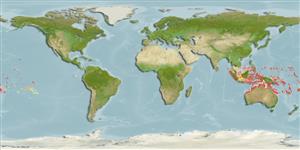>
Gobiiformes (Gobies) >
Gobiidae (Gobies) > Gobiinae
Etymology: Eviota: No etymology given, suggested by Christopher Scharpt: from Latin 'eu' for 'true' and 'iota' for anything very small, in combination 'truly very small' referring to it as being the smallest vertebrate at the time it has benn described by Jenkins (thus, making the suggestion by Scharpt plausible..
More on authors: Jordan & Seale.
Environment: milieu / climate zone / depth range / distribution range
Ecologia
marinhas associadas(os) a recifes; intervalo de profundidade 1 - 30 m (Ref. 86942). Tropical; 10°N - 23°S
Western Pacific: Vietnam, Indonesia (Moluccas), east and northward to Japan (Ryukyu Islands); east through Micronesia (Palau, Guam, Federated States of Micronesia [Yap], Kiribati [Gilbert Islands]); including New Caledonia, Samoa, and French Polynesia; south through Melanesia to Australia (Great Barrier Reef).
Tamanho / Peso / Idade
Maturity: Lm ? range ? - ? cm
Max length : 3.0 cm SL macho/indeterminado; (Ref. 48637)
Descrição suscinta
Chaves de identificação | Morfologia | Morfometria
Espinhos dorsais (total) : 7; Raios dorsais (total) : 8 - 9; Espinhos anais: 1; Raios anais : 6 - 7. This species is distinguished by the following characters: cephalic sensory-canal pore system lacks the IT pore (pattern 2); unbranched pectoral-fin rays; dorsal/anal-fin formula is 8/7; fifth pelvic-fin ray 40% of fourth ray; abdomen without the black peritoneum clearly visible externally; upper portion of pectoral-fin base with a dark spot when dead, and which is lacking or less visible in life; when alive. there is a distinctive red line running from the tip of the lower jaw back under the eye across the cheek (Ref. 107299).
Inhabits rubble of lagoon reefs (Ref. 37816). Also occurs in various reef habitats to about 15 meters depth (Ref. 48637). Occurs in small groups (Ref 90102).
Ciclo de vida ou comportamento de acasalamento
Maturities | Reprodução | Spawnings | Egg(s) | Fecundities | Larvas
Myers, R.F., 1991. Micronesian reef fishes. Second Ed. Coral Graphics, Barrigada, Guam. 298 p. (Ref. 1602)
Status na Lista Vermelha da UICN (Ref. 130435)
Ameaça para os humanos
Harmless
Uso pelos humanos
Ferramentas
Relatórios especiais
Baixar XML
Fontes da internet
Estimates based on models
Índice de diversidade filogenética (Ref.
82804): PD
50 = 0.5000 [Uniqueness, from 0.5 = low to 2.0 = high].
Bayesian length-weight: a=0.00708 (0.00333 - 0.01504), b=3.09 (2.92 - 3.26), in cm total length, based on LWR estimates for this (Sub)family-body shape (Ref.
93245).
Nível Trófico (Ref.
69278): 3.1 ±0.3 se; based on size and trophs of closest relatives
Resiliência (Ref.
120179): Elevada, tempo mínimo de duplicação da população menor que 15 meses (Preliminary K or Fecundity.).
Fishing Vulnerability (Ref.
59153): Low vulnerability (10 of 100).
Nutrients (Ref.
124155): Calcium = 355 [149, 895] mg/100g; Iron = 1.37 [0.61, 2.93] mg/100g; Protein = 17.7 [15.6, 19.5] %; Omega3 = 0.108 [0.040, 0.268] g/100g; Selenium = 29.9 [10.2, 81.7] μg/100g; VitaminA = 129 [28, 558] μg/100g; Zinc = 3.63 [2.11, 5.88] mg/100g (wet weight);
